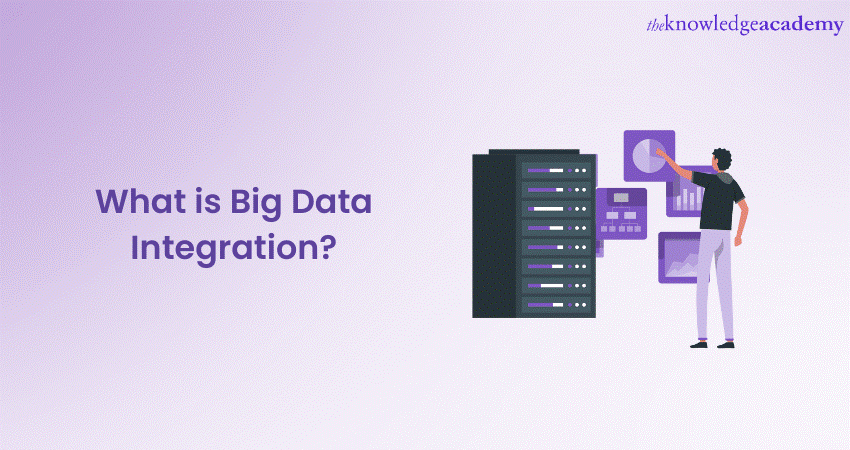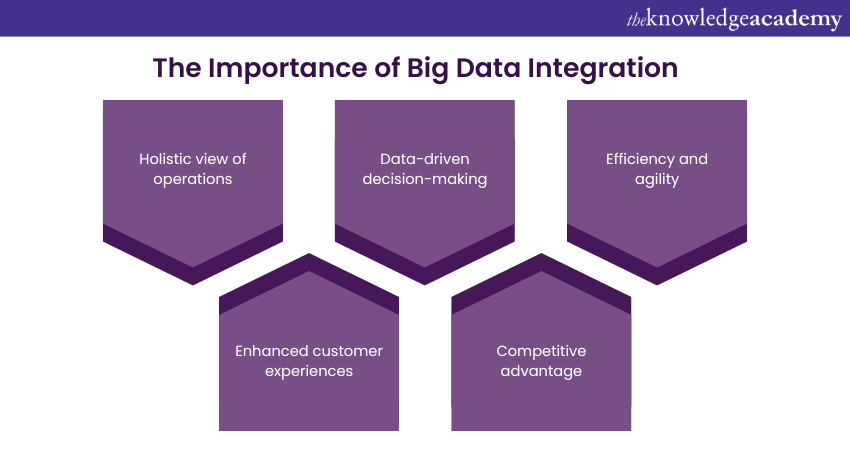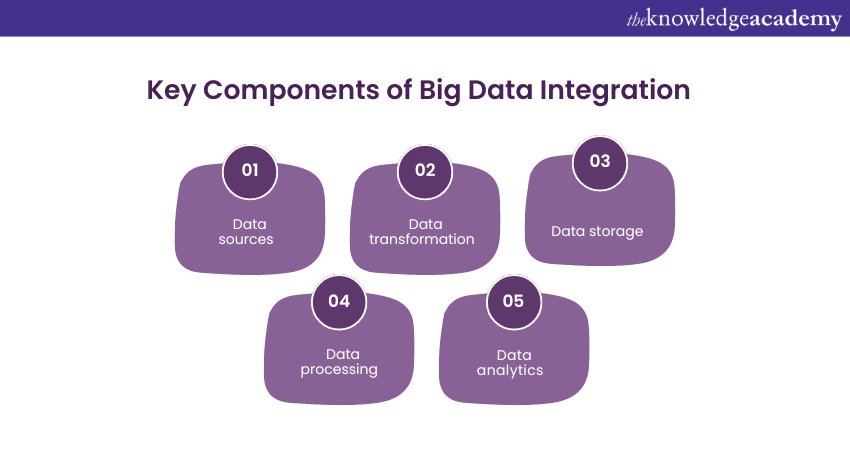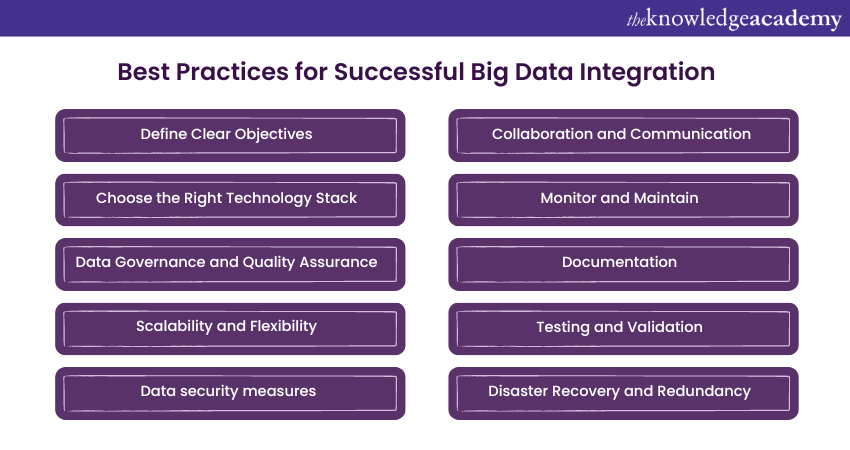We may not have the course you’re looking for. If you enquire or give us a call on +44 1344 203 999 and speak to our training experts, we may still be able to help with your training requirements.
Training Outcomes Within Your Budget!
We ensure quality, budget-alignment, and timely delivery by our expert instructors.

The modern-day organisation is constantly grappling with vast amounts of data coming from various sources. To make sense of this data and harness its potential, Big Data Integration has become a critical aspect of modern business operations. In this blog, we will delve into the concept of Big Data Integration, its importance, key components, and best practices.
Table of Contents
1) Defining Big Data Integration
2) Big Data Integration Process
3) The Importance of Big Data Integration
4) Key Components of Big Data Integration
5) Strategies of Big Data Integration
6) Best Practices for successful Big Data Integration
7) Conclusion
Defining Big Data Integration
Big Data Integration is the process of combining, harmonising, and managing vast and diverse datasets from various sources to provide meaningful insights and drive informed decision-making. In simpler terms, it's the art of making different data types and formats work together seamlessly. These sources could include structured data from databases, unstructured data from social media or sensor feeds, and everything in between.
The complexity of Big Data Integration arises from the 4 Vs – the sheer volume, velocity, variety, and veracity of data generated today. Traditional data integration techniques and tools often fall short when dealing with such massive and diverse datasets. Therefore, organisations turn to specialised technologies and strategies to tackle this challenge effectively.
Big Data Integration Process
Big data integration and processing are essential for making collected data valuable and useful. To derive meaningful insights from the vast amounts of data gathered from multiple sources, companies depend on data scientists, analysts, and engineers who use algorithms and other techniques.
Processing big data must comply with organisational governance standards to reduce decision-making risks, support organisational growth, manage costs, and improve operational efficiency and decision support.
The basic process involves:
a) Extracting data from various sources
b) Storing data appropriately
c) Transforming and integrating data with analytics
d) Orchestrating and using/loading data
Automated orchestration and loading of data into applications are crucial for success. Technologies that are not user-friendly can be cumbersome, hindering an organisation’s ability to effectively utilise big data.
The Importance of Big Data Integration
Now that we know the definition of data integration in Big Data, we will explore its importance. Big Data Integration is not just a buzzword; it's a crucial enabler for businesses aiming to gain a competitive edge in the market. Here are some reasons why it's so significant:

1) Holistic view of operations
One of the most significant advantages of Big Data Integration is its ability to provide a comprehensive view of an organisation's operations. In many businesses, data is generated from various departments, systems, and sources. Without integration, these data silos remain isolated, preventing a full understanding of how different aspects of the business interconnect.
For example, in a retail company, sales data, inventory data, customer feedback, and social media mentions are all valuable pieces of information. By integrating these disparate data sources, the company can gain insights into how customer sentiment affects sales, how inventory levels impact customer satisfaction, and more. This broader perspective enables businesses to make informed decisions that consider the entire ecosystem of their operations.
2) Data-driven Decision-making
Big Data Integration enables organisations to become more data-driven. Rather than relying on intuition, decision-makers can access a wealth of integrated data to inform their choices. This data-driven approach is especially valuable in highly competitive industries where even small advantages can be significant.
For example, in the financial sector, integrated data from market feeds, customer transactions, and economic indicators can help traders make split-second, profitable decisions. Similarly, healthcare providers can utilise integrated patient data to enhance treatment plans and improve patient outcomes.
3) Efficiency and Agility
Efficiency is crucial for success in any business. Big Data Integration streamlines data-related processes, reducing the time and effort required to access, process, and analyse information. When data is readily available and well-integrated, teams across the organisation can work more efficiently.
Additionally, integration enhances an organisation's agility. In today's dynamic market, businesses must quickly adapt to changing conditions. Integrated data allows for rapid responses to market shifts, emerging trends, and evolving customer demands. This agility provides a competitive edge that can distinguish between success and becoming obsolete
4) Enhanced Customer Experiences
Understanding customers and their preferences is essential for delivering exceptional experiences. Big Data Integration allows businesses to connect the dots between customer interactions, feedback, purchase history, and more. By creating a unified customer profile, companies can personalise their offerings, enhance customer service, and foster loyalty.
For example, e-commerce companies can use integrated data to recommend products based on a customer's browsing and purchasing history, leading to higher conversion rates. Similarly, in the hospitality industry, integrated guest data can help hotels provide tailored experiences, from room preferences to dining recommendations
5) Competitive Advantage
In a fiercely competitive landscape, those who can harness Big Data effectively gain a significant advantage. Integrated data enables businesses to identify trends early, predict market shifts, and innovate more rapidly than their competitors. This competitive edge can lead to market leadership and long-term sustainability.
For instance, in the automotive industry, manufacturers that integrate data from vehicle sensors can proactively identify maintenance needs, enhancing customer satisfaction and reducing costs. Likewise, in the technology sector, integrated usage data can drive product improvements and inform marketing strategies.
Unlock the power of Big Data analysis and elevate your skills with our comprehensive Big Data Analysis Training Course!
Key Components of Big Data Integration
Big Data Integration involves weaving together the diverse strands of data from various sources into a cohesive, usable fabric. Several key components play essential roles in the process of successful integration. Let's delve into these components and understand their significance in the world of Big Data.

1) Data sources
The starting point of any Big Data Integration initiative is the data sources. These sources can vary significantly and may include:
1) Structured data: Traditional databases, spreadsheets, and well-organised data in fixed formats.
2) Semi-structured data: Data with some structure but not as rigid as traditional databases, often found in XML, JSON, or log files.
3) Unstructured data: Data without a predefined structure, such as text documents, images, audio, and video files.
4) External data: Data from third-party sources like social media, public datasets, and APIs.
Each of these data sources may require different approaches and tools for integration. Understanding the nature of the data is crucial in determining how it should be processed and integrated into the overall data ecosystem.
2) Data transformation
Data rarely comes in a format that is directly usable for analysis or business operations. Data transformation involves the conversion of data from its raw state into a format that is suitable for integration and analysis. This transformation may include:
1) Data cleaning: Removing duplicates, correcting errors, and handling missing values to ensure data accuracy.
2) Data enrichment: Enhancing data with additional information, such as adding geographical coordinates to addresses or sentiment scores to text data.
3) Data normalisation: Ensuring that data adheres to consistent units, scales, or formats to facilitate comparisons.
4) Data aggregation: Combining and summarising data to create meaningful insights, often used in reporting and analytics.
Data transformation is a critical step that ensures the integrated data is of high quality and consistency.
3) Data storage
Once data is transformed and prepared, it needs a secure and scalable storage infrastructure. Big Data Integration often involves the use of various storage options, including:
1) Data warehouses: Central repositories that store structured and semi-structured data for analytics and reporting.
2) Data lakes: Flexible storage solutions that can accommodate structured, semi-structured, as well as unstructured data in their raw form.
3) NoSQL databases: Suitable for handling large volumes of diverse data types with high flexibility.
The choice of data storage depends on factors like the volume of data, the types of queries required, and the scalability needs of the organisation.
4) Data processing
Data processing is where the integrated data comes to life. It involves performing various operations on the data to extract insights, detect patterns, and generate meaningful results. Data processing can take several forms:
1) Batch processing: Analysing data in large, scheduled batches, which is useful for tasks like monthly reporting.
2) Real-time processing: Analysing data as it arrives, allowing for immediate actions or responses.
3) Stream processing: Continuously processing data streams suitable for applications like fraud detection or IoT sensor data analysis.
Tools and technologies like Apache Hadoop, Apache Spark, and stream processing frameworks facilitate data processing at scale.
5) Data analytics
The ultimate goal of Big Data Integration is to enable data analytics. This component involves using data to gain insights, make predictions, and support decision-making. Data analytics encompasses:
1) Descriptive analytics: Summarising historical data to understand what happened.
2) Predictive analytics: Using historical information to make predictions about future events or trends.
3) Prescriptive analytics: Recommending actions or strategies based on analysis to achieve specific outcomes.
Analytics tools and platforms, along with data visualisation tools, are crucial for extracting actionable insights from integrated data.
Level up your data science expertise and harness the power of Big Data analytics with our Big Data Analytics & Data Science Integration Course!
Strategies for Big Data Integration
An effective Big Data Integration strategy must encompass the following elements:
An effective big data integration strategy must encompass the following elements:
a) Data Governance: Ensure data is controlled and adheres to enterprise standards to maintain consistency and reliability.
b) Data Management and Risk Reduction: Implement robust data management practices to mitigate risks associated with data storage.
c) Data Compliance Controls: Establish appropriate controls to ensure compliance with data regulations and standards.
d) Data Quality Management: Maintain high data quality through regular monitoring and improvement initiatives.
e) Data Security Management: Protect data integrity and confidentiality with strong security measures.
f) Integration Needs Assessment: Understand the integration requirements between tools, consumers, and data sources to ensure seamless data flow.
g) Decision-Making Insights: Comprehend how, why, where, when, and what decisions are made using data, and ensure data supports these decisions effectively.
h) Big Data Architecture and Platform Capabilities: Align big data architecture and platforms with the broader data strategy to support and enhance data-driven decision-making.
With a solid data strategy in place, identify the tactics and technologies needed to support and improve organisational capabilities.
Best Practices for Successful Big Data Integration
Big Data Integration can be a complex and challenging endeavour, but following best practices can greatly increase the likelihood of success. Here, we explore key strategies and guidelines for achieving successful Big Data Integration.

1) Define Clear Objectives
Before starting a Big Data Integration project, it's crucial to define clear objectives. Understand the purpose of integrating data, the insights or outcomes you aim to achieve, and how integration aligns with your overall business goals. A well-defined purpose provides direction and ensures efforts are focused on delivering value.
2) Choose the Right Technology Stack
Selecting the appropriate technology stack is critical. Consider factors like the volume and variety of data, processing speed requirements, and budget constraints. Common components of a Big Data technology stack include data warehouses, data lakes, ETL (Extract, Transform, Load) tools, and data processing frameworks like Apache Hadoop or Apache Spark. Ensure your chosen stack aligns with your integration goals and can scale to meet future needs.
3) Data Governance and Quality Assurance
Maintaining data quality is paramount. Establish robust data governance practices that define data ownership, access controls, and data quality standards. Implement data cleansing, validation, and enrichment processes to ensure the accuracy and consistency of integrated data. Regularly monitor data quality and have mechanisms in place to correct errors promptly.
4) Scalability and Flexibility
Plan for scalability from the outset. As data volumes grow, your integration infrastructure should handle increased loads without major disruptions. Additionally, design your system with flexibility in mind. The data landscape evolves, and your integration solution should adapt to accommodate new data sources and formats as they emerge.
5) Data Security Measures
Data security is non-negotiable, especially when integrating data from diverse sources. Implement strong security measures to protect sensitive information. This includes encryption, access controls, regular security audits, and compliance with data protection regulations such as GDPR. Data masking and anonymisation techniques can further enhance privacy.
6) Collaboration and Communication
Successful Big Data Integration often involves cross-functional teams. Encourage collaboration between IT, data engineers, data scientists, and business stakeholders. Effective communication is key to aligning everyone's efforts and ensuring integration meets business needs. Regularly update stakeholders on progress and involve them in decision-making processes.
7) Monitor and Maintain
Integration is not a one-time project; it's an ongoing process. Establish robust monitoring and maintenance practices. Continuously monitor data flows, system performance, and data quality. Implement alerts for anomalies or errors requiring immediate attention. Regularly review and update integration processes to accommodate changing business requirements.
8) Documentation
Document all aspects of your Big Data Integration project comprehensively. This includes data source definitions, transformation logic, data lineage, and metadata. Proper documentation ensures team members can understand and maintain the integration processes effectively, even as team members change over time.
9) Testing and Validation
Thoroughly test your integration processes before deploying them in a production environment. Perform data validation tests to ensure integrated data is accurate and meets expected quality standards. Testing should cover different scenarios, including edge cases, to detect and correct any issues before they impact operations.
10) Disaster Recovery and Redundancy
Plan for disaster recovery and data redundancy. Regularly back up integrated data and have strategies in place to recover quickly from system failures or data breaches. Redundancy measures can include distributed data storage and backup systems to ensure data availability in case of unexpected events.
Conclusion
To sum it up, Big Data Integration enables organisations to harness the power of diverse data sources for informed decision-making. While the journey may be complex, adhering to best practices in objective definition, technology selection, data governance, and ongoing maintenance paves the way to success. With these principles in mind, businesses can unlock the true value of their data, gaining a competitive edge in the modern market.
Frequently Asked Questions

Integrate Big Data by using ETL (Extract, Transform, Load) processes, data lakes, and data warehouses. Employ tools like Apache Hadoop and Spark for processing, and ensure data governance and quality assurance to maintain accuracy and consistency throughout the integration.

Examples of data integration include combining customer data from CRM systems with sales data for comprehensive insights, merging sensor data from IoT devices with operational databases for predictive maintenance, and integrating social media analytics with marketing platforms for targeted campaigns.

The Knowledge Academy takes global learning to new heights, offering over 30,000 online courses across 490+ locations in 220 countries. This expansive reach ensures accessibility and convenience for learners worldwide.
Alongside our diverse Online Course Catalogue, encompassing 17 major categories, we go the extra mile by providing a plethora of free educational Online Resources like News updates, Blogs, videos, webinars, and interview questions. Tailoring learning experiences further, professionals can maximise value with customisable Course Bundles of TKA.

The Knowledge Academy’s Knowledge Pass, a prepaid voucher, adds another layer of flexibility, allowing course bookings over a 12-month period. Join us on a journey where education knows no bounds.

The Knowledge Academy offers various Big Data & Analytics Courses, including Hadoop Big Data Certification Training, Apache Spark Training and Big Data Analytics & Data Science Integration Course. These courses cater to different skill levels, providing comprehensive insights into Key Characteristics of Big Data.
Our Data, Analytics & AI Blogs cover a range of topics related to Big Data, offering valuable resources, best practices, and industry insights. Whether you are a beginner or looking to advance your Big Data and Marketing skills, The Knowledge Academy's diverse courses and informative blogs have got you covered.
Upcoming Data, Analytics & AI Resources Batches & Dates
Date
 Hadoop Big Data Certification
Hadoop Big Data Certification
Thu 23rd Jan 2025
Thu 20th Mar 2025
Thu 22nd May 2025
Thu 17th Jul 2025
Thu 18th Sep 2025
Thu 20th Nov 2025







 Top Rated Course
Top Rated Course



 If you wish to make any changes to your course, please
If you wish to make any changes to your course, please


